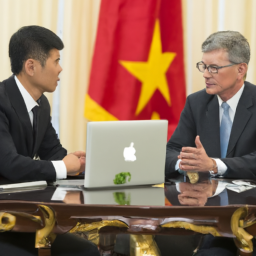Apple is considering increasing its purchases of components from Vietnam, following a growing trend among technology companies to diversify their supply chains beyond China. This strategy aims to reduce costs, minimize risks, and explore new opportunities in different markets.
During a meeting with Vietnamese Prime Minister Pham Minh Chinh in Hanoi on Tuesday, CEO Tim Cook promised to take action, as stated by Vietnam’s government.
According to the government, Apple has invested nearly $16 billion in Vietnam’s supply chain since 2019, as stated by Cook. Additionally, the company has generated over 200,000 job opportunities in the country.
Cook from Apple expressed readiness to increase collaboration and investment efforts in the Southeast Asian nation, as mentioned in the statement.
Article discusses how Vietnam’s growing economy presents the United States with a potential alternative to China.
The fact that he visited Vietnam underscores the country’s increasing significance to multinational corporations seeking options other than China due to the rising trade tensions between Beijing and Western countries in recent times.
According to Thuy Anh Nguyen, a strategist at Dragon Capital, a local fund management firm that focuses on investing in Vietnamese companies, Vietnam has greatly benefited from multinational companies shifting their manufacturing operations to different locations as a way to reduce reliance on China. This strategy, known as “China plus one,” has been advantageous for Vietnam.
Nguyen, who is in charge of a company that oversees $6 billion in assets, mentioned to CNN that the expenses related to workers in Vietnam’s manufacturing industry are approximately 50% lower compared to those in China.
Vietnam has shifted its focus from manufacturing low-value products such as textiles to producing higher-value tech products like iPhones and iPads. This advancement has allowed Vietnam to progress up the value chain.
According to Vietnam’s Ministry of Planning and Investment, the country attracted over $4.29 billion in foreign direct investment in the first two months of the year, showing a nearly 39% increase compared to the same period in 2023. The majority of the new investments were directed towards the processing and manufacturing industry.
An ideal destination for manufacturers has been found in fast-growing Asian economies such as Vietnam and India, as relationships between Beijing and Western countries have become strained.
According to Dan Ives, a senior equity analyst at Wedbush Securities, Vietnam is an ideal location for tech companies looking to expand beyond China due to its abundance of skilled engineers.
In an interview with CNN, he mentioned that the focus is not only on producing cheap electronics, but also on moving towards more advanced products. This shift in focus was not even considered by foreign companies two years ago.
After being enemies during a war, the relationship between the United States and Vietnam has improved significantly. The value of goods imported from Vietnam to the US increased by over 360% in the decade leading up to the end of 2023, exceeding $144 billion according to data from the US government.
In September, both countries officially elevated their diplomatic relationship to a “comprehensive strategic partnership,” signifying a significant step that highlights Vietnam as an attractive option for increased investment from the US. This includes investments in essential technologies such as semiconductor chips.
Intel has recognized the growth of Vietnam as well. In 2021, the company announced plans to invest $1.5 billion in a large campus near Ho Chi Minh City, with the purpose of establishing their biggest assembly and test facility globally.
Meanwhile, the relationship between the United States and China has worsened. The trade dispute between the two nations started in 2018 when the U.S. imposed tariffs on a variety of Chinese goods. Tensions escalated further last year as both countries implemented export controls in the chipmaking industry in retaliation against each other.
Throughout the pandemic, China’s rigorous zero-Covid approach disrupted worldwide supply chains, highlighting the dangers of centralizing production in one specific location.
In 2022, the largest iPhone factory in the world, which is situated in central China and owned by Foxconn, a Taiwanese manufacturing company, had to close temporarily because workers protested due to concerns about the coronavirus spreading.
The consumer market in Vietnam is appealing to foreign tech companies because of the growing, well-educated, and young population. This makes it easier for companies to find skilled workers for their factories and potential customers for their products.
She mentioned that Vietnam’s population is 100 million people, which would make it the largest country in Europe if it were located there. She also pointed out that the use of smartphones in Vietnam was growing quickly.
According to the International Monetary Fund, Vietnam’s economy is projected to grow by 5.8% this year, which is significantly higher than the global average of 3.2%. The IMF predicts a growth of 6.5% for Vietnam in 2025, which is close to the pace of expansion seen in India.
Nevertheless, Vietnam is a smaller market compared to India. India has been attracting big foreign companies like Tesla to establish factories in the country.
Currently, foreign companies find Vietnam appealing mainly because of its supply chain advantages, according to Ives from Wedbush Securities. In contrast, India is seen as attractive for both its supply chain and demand.

